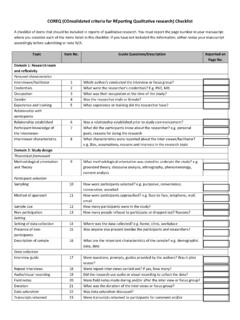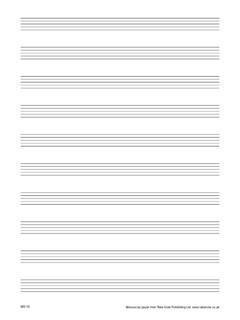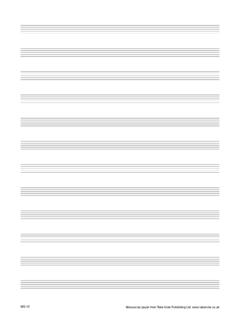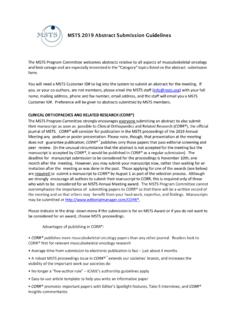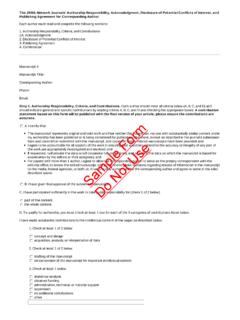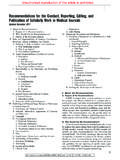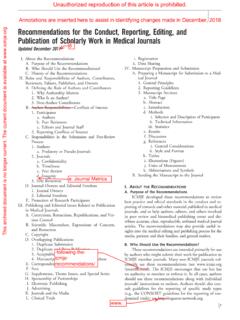Transcription of Writing Papers for Biomaterials - cdn.elsevier.com
1 Writing Papers for Biomaterials Professor , Editor-in-Chief and Peggy O'Donnell, Managing Editor Introduction Biomaterials is the leading journal that deals with Biomaterials science and the related subjects of biocompatibility, medical devices, drug and gene delivery and tissue engineering. We are receiving manuscripts at 250 per month and publish over 7,000. pages per year. The high quality of the journal is beyond doubt. The maintenance, and hopefully even further improvement, of this quality is the concern and responsibility of authors, the editorial team, the referees and the publisher. The review process is central to the production of high quality published Papers . The procedure, in general terms, is as follows. Manuscripts are received in the editorial office, via an online web submission and review system, and are read by the Editor- in-Chief.
2 At this point the manuscript may be rejected because it does not match the scope of the journal. Only a few percent of manuscripts come into this category. The manuscript may also be rejected at this stage because, in the Editor's opinion, the quality of the paper is not sufficient to justify publication or because there would be very limited interest by the readership of the journal in the paper . This decision is never an easy one and the Editor takes into account the added value of the paper in comparison to other Papers being published in Biomaterials in that specific area. Thus, a manuscript dealing with a slightly different way of sintering hydroxyapatite, or delivering a well-known drug in a slightly different manner, might be difficult to accept in view of the large number of Papers on those subjects published recently.
3 Approximately 35% of manuscripts are rejected on this basis, and the author is advised accordingly, usually within a couple of weeks and with a personalised letter of explanation. If the Editor-in-Chief believes that the manuscript is of sufficient quality and interest to be peer reviewed, he will select appropriate referees from his database. The manuscript and abstract are sent by e-mail to referees who are invited to accept or decline the invitation within 10 days. If the referee agrees to conduct the review he is requested to complete his assessment and provide his report, in the EES web system, within three weeks. If a referee cannot review the paper , for any reason, the manuscript is sent to an alternate reviewer. This continues in cascade until the required number of reports is received.
4 When the referee reports have been received, the Editor-in-Chief reads them and re-reads the manuscript. At this point he will either reject the paper , accept it without revision or request that the author revises the manuscript. A further 40% are rejected at this stage. Very few are accepted without revision. The authors normally receive copies of the referee's reports, although on occasion the Editor-in-Chief consolidates the referee's comments into his own report on the manuscript. If a revision is required, the authors are usually requested to complete this within a short, defined period of time, usually between 1 and 3 weeks. This time limit is specified to avoid the publication of work that becomes out of date. If revised manuscripts are received after the deadline, the editorial office may decide to have the paper re-refereed.
5 It should be noted that only rarely will the Editor-in- Chief require that significant additional experimental work is required. If referees suggest that more work needs to be done in order to make the work publishable, the Editor-in-Chief will usually reject the paper , with a recommendation to the author. It will be seen from the above summary that some 75-80% of manuscripts are rejected and 95% of those eventually accepted have to be revised. These are not exceptional figures for a high quality scientific journal. It is unlikely that the rejection rate will be lowered since it is the intention to increase the quality of the journal, so that the acceptance criteria will be gradually raised. There are, however, many ways in which the overall quality of submitted manuscripts can be improved.
6 This is important for several reasons. Too many manuscripts are received with obvious errors and poor quality presentation, which makes the editorial and review process more time consuming and difficult. It is not an easy task persuading referees to review Papers and it is clear that they usually respond positively to well presented manuscripts but negatively ( by refusing to do the review, or being late with the report) with poorly presented scripts. Obviously the shorter the editorial process the quicker will be the publication of the paper . This present paper has been produced to give advice to authors on the presentation and submission of manuscripts to Biomaterials from the editorial perspective. It is not concerned with the logistics of submission, although a few aspects of this will be touched upon.
7 It will cover manuscript content, style and length and will deal specifically about each part of a manuscript, from title to references. Manuscript Content Types of Manuscripts Papers published in regular issues of Biomaterials are normally original research Papers . Some Review Papers are published but these are specially commissioned by the Editor-in-Chief. Leading Opinion Papers , which provide evidence-based scientific opinions on topical and important issues in Biomaterials science, are also commissioned by the Editor-in-Chief. In both these cases, we do not accept unsolicited Papers although the Editor would be happy to receive proposals for manuscripts in either category. Scope Because of the changing role of Biomaterials in many areas of medical technology, the scope of the Journal is constantly evolving.
8 The journal is relevant to all applications of Biomaterials including implantable medical devices, tissue engineering and drug delivery systems. Indeed the journal is now divided into 9 sections, Biomaterials &. Tissue Engineering, Biomaterials & Drug Delivery, Biomaterials & Medical Devices, Biomimetic & Natural Materials, Biocompatibility, The Materials Science of Biomaterials , Modelling of Biomaterial Performance, Biomaterials and Gene Transfer and Biomaterials for Biotechnology. Authors are requested on submission to specify the most appropriate section although the Editor-in-Chief may override the selection. It is very important that authors remain within the limits set out by these instructions. Thus, whilst we accept and indeed encourage manuscripts on drug delivery systems, the work must address materials science issues of these systems and not solely the pharmacology.
9 Similarly, Papers dealing with implantable devices must relate to the materials of those devices and not solely to clinical performance or biomechanics. Page 2. Papers dealing with the synthesis and characterisation of new materials that might have potential as Biomaterials cannot be accepted unless they are able to demonstrate some relevant biological performance data. Any manuscript that does not mention the materials actually used cannot be accepted and detailed information about the materials is normally required. It should also be noted that we rarely publish Papers that only describe techniques, without any substantive new Biomaterials science content. Intellectual Property Quite often, questions about proprietary names, trademarks or materials of an undisclosed specification, arise and great care has to be taken.
10 It is acceptable for a material or a device to be described by a trade name as long as there is also a description of that material or device. However, we normally prefer that trade name not to be used in the title or in the list of key words. It is not acceptable for a paper to discuss a material that cannot be specified for confidentiality reasons. It should also be said that all authors have the responsibility of ensuring that they consider the intellectual property implications of manuscript submission. Authors should be aware that the act of transmitting a manuscript to an editor, with the implicit assumption that the manuscript will be sent to referees, has already undertaken an act of disclosure which some legal jurisdictions may argue prevents a patent filing related to any aspect of the subject matter of the manuscript.
